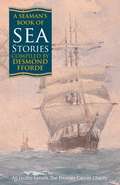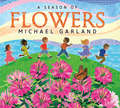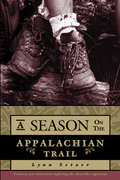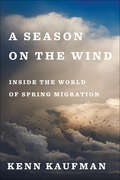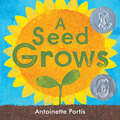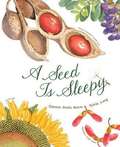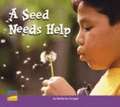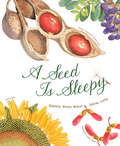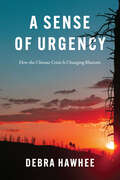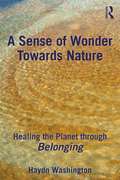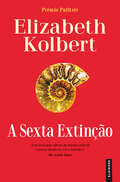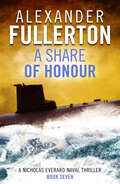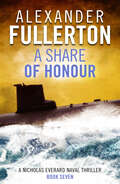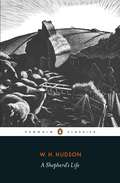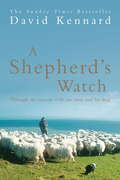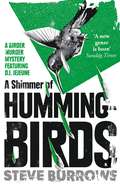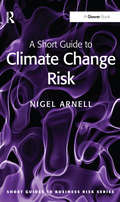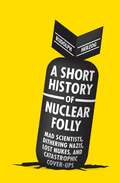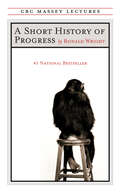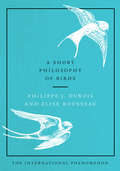- Table View
- List View
A Sea of Glass: Searching for the Blaschkas' Fragile Legacy in an Ocean at Risk (Organisms and Environments #13)
by Drew HarvellIt started with a glass octopus. Dusty, broken, and all but forgotten, it caught Drew Harvell's eye. Fashioned in intricate detail by the father-son glassmaking team of Leopold and Rudolf Blaschka, the octopus belonged to a menagerie of unusual marine creatures that had been packed away for decades in a storage unit. More than 150 years earlier, the Blaschkas had been captivated by marine invertebrates and spun their likenesses into glass, documenting the life of oceans untouched by climate change and human impacts. Inspired by the Blaschkas' uncanny replicas, Harvell set out in search of their living counterparts. In A Sea of Glass, she recounts this journey of a lifetime, taking readers along as she dives beneath the ocean's surface to a rarely seen world, revealing the surprising and unusual biology of some of the most ancient animals on the tree of life. On the way, we glimpse a century of change in our ocean ecosystems and learn which of the living matches for the Blaschkas' creations are, indeed, as fragile as glass. Drew Harvell and the Blaschka menagerie are the subjects of the documentary Fragile Legacy, which won the Best Short Film award at the 2015 Blue Ocean Film Festival & Conservation Summit. Learn more about the film and check out the trailer here. See the Blaschka collection in person at the Corning Museum of Glass beginning in May 2016. Click here for more information.
A Seaman's Book of Sea Stories
by Desmond FfordeAn attraction that can't be ignored. A spoilt little rich girl. A rough ex-soldier. When Callie Frobisher and Paul Mason are stranded after their plane crashes, the mismatched couple are forced into battling each other and their feelings... Callie has it all - rich parents, a private education, and a great job, whilst Paul is harbouring a dark and destructive secret.The trauma of the crash and the harsh media spotlight proves to be challenging for them both. Can their attraction survive when they return to reality?
A Season of Flowers (Tilbury House Nature Book #0)
by Michael GarlandMichael Garland (Daddy Played the Blues) displays his impressive illustration range with the stylized, country-quilt, digital collage illustrations of A Season of Flowers. Snowdrops and crocuses yield to tulips and hyacinths, then dogwood blossoms, iris, lupine, daisies, morning glories, daylilies, geraniums, peonies, sunflowers, roses, and chrysanthemums as spring passes to summer, then autumn. At last the garden slumbers into winter under a blanket of snow, preparing next year’s procession of blooms. Like actors crossing a stage, flowers narrate the passing seasons in the first person, each one briefly proclaiming its unique and vital role in the natural world. Backmatter descriptions complete this child’s introduction to a garden year, in which the passage of time is vividly realized. Fountas & Pinnell Level L
A Season on the Trail
by Lynn SetzerA compilation of stories from thru-hikers, a unique group of people who every year brave a 2,100 mile trail through every type of weather, every type of circumstance. Gathered from trail registers, postcards, and personal interviews, these voices come alive and evoke the true spirit of the Appalachian Trail, from the lows of ten consecutive days of rain and cold, to the highs of beautiful sunsets and camaraderie.Each spring, a group of people attempt a thru-hike of the Appalachian Trail. Setzer follows these determined hikers from Georgia to Maine. In this new edition, hikers reveal five years later how their experiences on the Trail changed their lives.'Originally, I was attracted to the AT for the adventure of walking the whole thing at once... Even as I finished, I did not understand those who chose to repeat the walk. But the next spring I found I wanted to go. And I understood that you never walk the same trail twice... I learned that I walk to fill my heart with wonder, to feed my soul.' - Merlin 'I know I'll be out there again. I don't know when and I don't know with whom. But I know, once more I'll live the nomadic life I loved on the Appalachian Trail.' - Trail GimpWhether documenting their journey or contemplating its impact on their lives, the voices in A Season on the Appalachian Trail will entrance you with their honesty and humanity.
A Season on the Wind: Inside the World of Spring Migration
by Kenn KaufmanA close study of one season along Lake Erie that reveals the amazing science and magic of spring bird migration, and the perils of human encroachment. “Kenn Kaufman knows his birds and their miraculous journeys—and he feels them deeply, too. An enlightening, thought-provoking, and poignant read.” —Jennifer Ackerman, author of The Genius of BirdsEvery spring, billions of birds sweep north, driven by ancient instincts to return to their breeding grounds. This vast parade often goes unnoticed, except in a few places where these small travelers concentrate in large numbers. One such place is along Lake Erie in northwestern Ohio. There, the peak of spring migration is so spectacular that it attracts bird watchers from around the globe, culminating in one of the world’s biggest birding festivals. Millions of winged migrants pass through the region, some traveling thousands of miles, performing epic feats of endurance and navigating with stunning accuracy. Now climate change threatens to disrupt patterns of migration and the delicate balance between birds, seasons, and habitats. But wind farms—popular as green energy sources—can be disastrous for birds if built in the wrong places. This is a fascinating and urgent study of the complex issues that affect bird migration.“Kaufman soars above his Ohio home place and artfully shares the world of birds and the miraculous feats of migration that persist amidst constant conservation struggles and hard-won successes.” —J. Drew Lanham, author of The Home Place“A Season on the Wind will transform the way we see birds and the season of spring!” —Melissa Groo, wildlife photographer and conservationist
A Seed Grows
by Antoinette PortisThe transformative life cycle of a sunflower plays out in this bold read-aloud by Sibert honoree Antoinette Portis. <p><p>To understand how a seed becomes a sunflower, you have to peek beneath the soil and wait patiently as winding roots grow, a stalk inches out of the earth, and new seeds emerge among blooming petals. <p><p>"A seed falls, And settles into the ground, And the Sun shines, And the rain comes down, And the seed grows…" Leading up to a striking fold-out spread of a full-grown sunflower, the lively, bold illustrations in A Seed Grows offer a close-up view of each step of the growth cycle. Additional material in the back of the book explains the science of plant life cycles, and goes into more detail on the ways in which flowers and seeds depend on other creatures. <P><P><i>Advisory: Bookshare has learned that this book offers only partial accessibility. We have kept it in the collection because it is useful for some of our members. Benetech is actively working on projects to improve accessibility issues such as these.</i>
A Seed Is Sleepy
by Dianna Hutts Aston Sylvia LongAward-winning artist Sylvia Long and author Dianna Hutts Aston have teamed up again to create this gorgeous and informative introduction to seeds. Poetic in voice and elegant in design, the book introduces children to a fascinating array of seed and plant facts, making it a guide that is equally at home being read on a parent's lap as in a classroom reading circle.
A Seed Needs Help
by Katherine Scraper David HaggertyIn this book, explore the things a seed needs to grow.
A Seed is Sleepy
by Dianna Hutts Aston Sylvia Long<p>Award-winning artist Sylvia Long and author Dianna Hutts Aston have teamed up again to create this gorgeous and informative introduction to seeds. Poetic in voice and elegant in design, the book introduces children to a fascinating array of seed and plant facts, making it a guide that is equally at home being read on a parent's lap as in a classroom reading circle. <p>This is a fixed-format ebook, which preserves the design and layout of the original print book.</p>
A Selkie's Magic
by Lana Lea ShortA Selkie's Magic, Book 1 in the new fantasy series The Selkies Heart by romance author Lana Lea Short. This thrilling tale of intrigue, passion, myths, and legends will keep you turning the pages to find out what happens when a sexy surfer from California meets a Selkie prince.Aileana Sutherland is a strong-willed, independent young Southern California surfer who decides to move to Scotland, her father's homeland. She's prompted to relocate after an awful heart-wrenching breakup with her boyfriend, who she caught having sex with another woman Scotland is the perfect place to lick her wounds and move on with her life.There, she runs into a man from her past, Kendrick Morgan. A man with gorgeous long, dark hair with the body of a god; a man with a secret. He happens to be a shapeshifting Selkie Prince, a creature of Celtic myths and legends.Kendrick and his Selkie clan are tasked with protecting the locals from evil Unseelies in the form of Finfolk. There have been reports of kidnapping, but when Aileana is abducted, will Kendrick be able to save the woman he's given his heart to? Content Notes: Spicy, Fantasy, Contemporary, Sea Creatures, Selkies
A Sense of Urgency: How the Climate Crisis Is Changing Rhetoric
by Debra HawheeA study of how the climate crisis is changing human communication from a celebrated rhetorician. Why is it difficult to talk about climate change? Debra Hawhee argues that contemporary rhetoric relies on classical assumptions about humanity and history that cannot conceive of the present crisis. How do we talk about an unprecedented future or represent planetary interests without privileging our own species? A Sense of Urgency explores four emerging answers, their sheer novelty a record of both the devastation and possible futures of climate change. In developing the arts of magnitude, presence, witness, and feeling, A Sense of Urgency invites us to imagine new ways of thinking with our imperiled planet.
A Sense of Wonder Towards Nature: Healing the Planet through Belonging
by Haydn WashingtonEnvironmental scientist and writer Haydn Washington argues that we will not solve the environmental crisis unless we change our worldview and ethics, and to do so we must rejuvenate our sense of wonder at nature. This book focuses on humanity’s relation with nature, and the sense of wonder and belonging common to indigenous cultures and children everywhere. Drawing on events in the author’s own four decades working to protect wild places, and the current literature on wonder, it examines what a sense of wonder is, what it has been called in different cultures, and our high points of wonder at nature. It also looks at the ‘Great Divide’ in worldview between anthropocentrism and ecocentrism, and considers the problem of anthropocentric theory in academia, arguing that the focus should instead be on harmony with nature. The book concludes with an examination of why wonder has become buried in Western society and considers ways in which it can be revived, including rituals and education. It also considers how wonder helps humanity to become ‘whole’. The final chapter presents the road back to wonder and how wonder towards nature can be restored in Western society. This book will be of great interest to environmental scientists, conservation biologists, environmental philosophers and ecological ethicists, as well as environmentalists, educators, eco-psychologists, and students looking at sustainability, deep ecology, and environmental philosophy and ethics.
A Sense of the Future: Essays in Natural Philosophy
by Jacob BronowskiScientist, humanist, optimist, the late Jacob Bronowski in these essays explores the singularity of humankind, the essence of science, and the idea of a life force antecedent to nature.
A Sexta Extinção
by Elizabeth KolbertLeitura recomendada por Yuval Noah Harari, Al Gore, Bill Gates e Barack Obama, A Sexta Extinção é considerado um dos livros de divulgação científica mais importantes dos últimos anos, tendo sido finalista do National Book Critics Award e vencedor do Prémio Pulitzer para obras de não-ficção. Nos últimos 500 milhões de anos, a Terra passou por cinco extinções em massa, nas quais a diversidade da vida no planeta se reduziu drástica e subitamente. Atualmente, e pela primeira vez na História, decorre um processo de extinção em massa provocado por uma única espécie: o Homem. Nos últimos dois séculos, provocámos danos irreparáveis no clima e ecossistema global; como consequência direta, mais de um quarto de todos os mamíferos da Terra está hoje em vias de extinção, tal como acontece com 40% dos anfíbios, um terço dos corais e dos tubarões, um quinto dos répteis e um sexto das aves. Considerado um dos livros de divulgação científica mais relevantes dos últimos anos, A Sexta Extinção é leitura recomendada por personalidades como YuvalNoah Harari, Al Gore, Bill Gates ou Barack Obama. Neste seu valioso trabalho, Elizabeth Kolbert combina os resultados de uma extensa investigação no terreno com a história das ideias e o trabalho de geólogos, botânicos e biólogos marinhos, produzindo um documento inédito e, mais do que isso, um apelo urgente para que, repensando o nosso papel no planeta, não deixemos como derradeiro legado uma sexta extinção. «Um livro maravilhoso e um aviso muito claro de que mudanças repentinas são possíveis de ocorrer. Já aconteceram no passado e podem vir a repetir-se.» Barack Obama «Um livro que altera de forma radical o nosso modo de ver o mundo.» The Seattle Times «As longas viagens que Elizabeth Kolbert realizou durante a pesquisa para este livro e o tratamento detalhado tanto dos factos históricos como dos científicos, fazem de A Sexta Extinção um contributo muito valioso para a compreensão das nossas circunstâncias atuais.» Al Gore, The New York Times Book Review «Kolbert mostra nestas páginas que é capaz de escrever poeticamente sobre os animais em vias de extinção, mas o verdadeiro poder deste livro reside nos factos científicos e no contexto histórico apresentados pela autora, ao documentar as perdas crescentes que o Homem está a provocar.» The New York Times
A Share of Honour (Nicholas Everard Naval Thrillers #4)
by Alexander FullertonDanger lurks beneath the Mediterranean waves… Sub-lieutenant Paul Everard serves in the Mediterranean aboard the submarine Ultra, helping the Allies attack Axis supply ships in a life or death struggle beneath the waves. But Paul has other worries: his father, Nick, is somewhere in the Far East, at risk from the rapidly advancing Japanese. His brother, Jack, has become embroiled in the murky world of clandestine operations, and been sent on a high-risk mission to destroy a key German naval base.The Everards are risking everything for the war. But what price is too high for one family to bear? The seventh instalment of the Nicholas Everard Naval Thrillers is a searing adventure of warfare at sea, perfect for fans of Alan Evans and David McDine.Praise for The Nicholas Everard Naval Thrillers‘The prose has a real sense of urgency, and so has the theme. The tension rarely slackens.’ Times Literary Supplement‘The research is unimpeachable and the scent of battle quite overpowering.’ The Sunday Times‘The accuracy and flair of Forester at his best… carefully crafted, exciting and full of patiently assembled technical detail that never intrudes on a good narrative line’ Irish Times
A Share of Honour (Nicholas Everard Naval Thrillers)
by Alexander FullertonDanger lurks beneath the Mediterranean waves… Sub-lieutenant Paul Everard serves in the Mediterranean aboard the submarine Ultra, helping the Allies attack Axis supply ships in a life or death struggle beneath the waves. But Paul has other worries: his father, Nick, is somewhere in the Far East, at risk from the rapidly advancing Japanese. His brother, Jack, has become embroiled in the murky world of clandestine operations, and been sent on a high-risk mission to destroy a key German naval base.The Everards are risking everything for the war. But what price is too high for one family to bear? The seventh instalment of the Nicholas Everard Naval Thrillers is a searing adventure of warfare at sea, perfect for fans of Alan Evans and David McDine.Praise for The Nicholas Everard Naval Thrillers‘The prose has a real sense of urgency, and so has the theme. The tension rarely slackens.’ Times Literary Supplement‘The research is unimpeachable and the scent of battle quite overpowering.’ The Sunday Times‘The accuracy and flair of Forester at his best… carefully crafted, exciting and full of patiently assembled technical detail that never intrudes on a good narrative line’ Irish Times
A Shepherd's Life
by W. H. HudsonConsidered a classic at the time of its publication in 1910, A Shepherd's Life is a rare account of the lives of those who lived on and worked the land in nineteenth-century rural Britain. A masterful work of prose, W. H. Hudson focuses on the story of one man, a Wiltshire shepherd named Caleb Bawcombe, whose tales of sheep dogs, farmer's wives, poachers and local fairs become a sublime account of a way of life that has largely disappeared from these shores.
A Shepherd's Watch
by David KennardCharismatic David Kennard lives a life most people can only dream about. Farming on a spectacularly beautiful part of the Devon coast he has an almost telepathic bond with nature and with his working sheepdogs. His is a life filled with daily challenges, from the battles with wild Atlantic weather to the dramas of clifftop rescue, but it is also a life full of the richness of rebirth, and the Herriotesque delight in a way of life that has remained almost untouched by the modern world.Part diary, part homage to the countryside and the canine family that is so much a part of his life, David Kennard's extraordinary book is designed to touch the hearts and minds of city and country dwellers alike.
A Shimmer of Hummingbirds: A Birder Murder Mystery
by Steve BurrowsChief Inspector Domenic Jejeune hopes an overseas birding trip will hold some clues to solving his fugitive brother&’s manslaughter case. Meanwhile, in Jejeune&’s absence his long-time nemesis has been drafted in as cover to investigate an accountant&’s murder. And unfortunately Marvin Laraby proves just a bit too effective in showing how an investigation should be handled. With the manslaughter case poised to claim another victim, Jejeune learns an accident back home in Britain involving his girlfriend, Lindy, is much more than it seems. Lindy is in grave danger, and she needs Jejeune. Soon, he is faced with a further dilemma. He can speak up on a secret he has discovered relating to Laraby&’s case, knowing it will cost his job on the north Norfolk coast he loves. Or he can stay silent, and let a killer escape justice. Turns out that sometimes the wrong choice is the only one there is.
A Shooting Guide for the Blind
by Carey McWilliamsThis is a guide regarding the proper application of firearms, especially by those with any degree of visual impairment, with an emphasis on safe firearms usage when engaging in activities such as hunting, target shooting, and even self-defense at home or on the street. Author Carey McWilliams became the first totally blind person to obtain a concealed carry license in 2001. In this book, he utilizes his thirty years of certified gun training to teach others with visual impairments, as well as those seeking to train them, all the various methods that have allowed him to pass countless shooting exams to obtain a number of state-issued concealed carry permits and hunting licenses. For this guide's creation, real guns from the author's personal firearms collection were used as props for certain technical sections, as well as old written text and recorded lectures obtained during his training through the National Rifle Association, law enforcement, and even the United States Army. Topics include how to identify, load, unload, and work with different types of firearms without the benefit of sight, how the military's techniques in close-quarters combat governs defensive shooting by the blind, case studies and official government research debunking the myth that blind people pose a greater danger than the sighted regarding firearm usage, and how to find resources to obtain training certification.
A Short Guide to Climate Change Risk (Short Guides to Business Risk)
by Nigel ArnellClimate change poses a risk to business operations and to markets, and a poor business response to this risk can lead to reputational damage, or worse. At the same time, climate change can bring opportunities for some businesses. In this addition to Gower’s series of Short Guides to Business Risk, Professor Arnell, one of the world’s leading experts in the field, reviews this critical area of risk posed to businesses and other organisations by climate change and considers how they can respond to this threat. A Short Guide to Climate Change Risk focuses on the impacts and consequences of climate change rather than on business use of energy or business and 'sustainability' issues. The author examines the advantages and disadvantages of different approaches to addressing these risks, with international case study examples. With chapters on the nature, science and politics of climate change, on the assessment and management of climate change risks, and recommendations for incorporating climate change risks into a Company Risk Management System, this concise guide serves the needs of business students and practitioners across a wide range of sectors, public and private.
A Short History of Nuclear Folly: Mad Scientists, Dithering Nazis, Lost Nukes, and Catastrophic Cover-ups
by Jefferson Chase Rudolph HerzogIn the spirit of Dr. Strangelove and The Atomic Café, a blackly sardonic people's history of atomic blunders and near-misses revealing the hushed-up and forgotten episodes in which the great powers gambled with catastrophe. Rudolph Herzog, the acclaimed author of Dead Funny, presents a devastating account of history's most irresponsible uses of nuclear technology. From the rarely discussed nightmare of "Broken Arrows" (40 nuclear weapons lost during the Cold War) to "Operation Plowshare" (a proposal to use nuclear bombs for large engineering projects, such as a the construction of a second Panama Canal using 300 H-Bombs) . . . Herzog focuses in on long-forgotten nuclear projects that nearly led to disaster.Digging deep into archives, interviewing censored scientists, and including dozens of photos, Herzog also explores the "accidental" drop of a Nagasaki-type bomb on a train conductor's home, the implanting of plutonium into patients' hearts, and the invention of wild tactical nukes, including weapons designed to kill enemy astronauts.Told in a riveting narrative voice, Herzog--the son of filmmaker Werner Herzog--also draws on childhood memories of the final period of the Cold War in Germany, the country once seen as the nuclear battleground for NATO and the Warsaw Pact, and discusses evidence that Nazi scientists knew how to make atomic weaponry ... and chose not to. An unprecedented people's history.
A Short History of Progress: Fifteenth Anniversary Edition (The CBC Massey Lectures)
by Ronald WrightNow more relevant than ever, Ronald Wright’s #1 national bestseller, A Short History of Progress. The fifteenth anniversary edition includes a new introduction warning of the accelerating patterns of progress and disaster.Each time history repeats itself, so it’s said, the price goes up. The twentieth century was a time of runaway growth in human population, consumption, and technology, placing a colossal load on all natural systems, especially earth, air, and water — the very elements of life. The most urgent questions of the twenty-first century are: Where will this growth lead? Can it be consolidated or sustained? And what kind of world is our present bequeathing to our future?In his #1 national bestseller A Short History of Progress Ronald Wright argues that our modern predicament is as old as civilization, a 10,000-year experiment we have participated in but seldom controlled. Only by understanding the patterns of triumph and disaster that humanity has repeated around the world since the Stone Age can we recognize the experiment’s inherent dangers, and, with luck and wisdom, shape its outcome. In his new introduction to the fifteenth anniversary edition, Wright looks at the past fifteen years of human innovation — and asks whether we can still get the future right.
A Short Introduction to Climate Change
by Tony EggletonA Short Introduction to Climate Change provides a clear, balanced and well documented account of one of the most important issues of our time. It covers developments in climate science over the past 250 years and shows that recent climate change is more than the result of natural variability. It explains the difference between weather and climate by examining changes in temperature, rainfall, Arctic ice and ocean currents. It also considers the consequences of our use of fossil fuels and discusses some of the ways to reduce further global warming. Tony Eggleton avoids the use of scientific jargon to provide a reader-friendly explanation of the science of climate change. Concise but comprehensive, and richly illustrated with a wealth of full-colour figures and photographs, A Short Introduction to Climate Change is essential reading for anyone who has an interest in climate science and in the future of our planet.
A Short Philosophy of Birds
by Philippe J Dubois Elise Rousseau“Brilliant, magical and engrossing–I will never see birds the same way again.” — Peter Wohlleben, author of The Hidden Life of TreesTHE INTERNATIONAL PHENOMENONTwenty-two short lessons from the secret lives of birds on living harmoniously and reconnecting with nature.This charming volume on bird behavior invites us to take a step back from our busy lives and to listen to the tiny philosophers of the sky. From the delicate sparrow to the majestic eagle, birds are among the most fascinating species on earth, and there is much to be learned from these paragons of beauty and grace that can be applied to our lives, including:Independence: what it means to be “pushed out of the nest.”Vulnerability: what the mallard teaches us about giving up our old feathers for new ones in order to fly.Gender equality: what happens when a papa Turtledove sits on the nest.Hierarchy and power: what the raven and the vulture know about the pecking order.Filled with elegant illustrations of bird species, this gem of a book celebrates of our friends in the sky, and what they can teach us about the rhythms of life.

